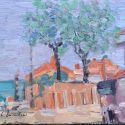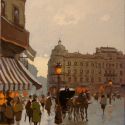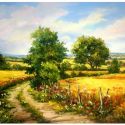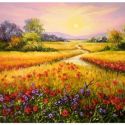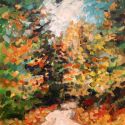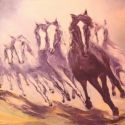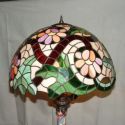Born on 04 August 1853: John Henry Twachtman, US Impressionist painter and printmaker who died on 18 August 1902.
Born in in Cincinnati to German immigrant parents, Twachtman received early artistic training in his hometown. He began his career decorating window shades and studied drawing at the Ohio Mechanics Institute and McMicken School of Design.
In 1875, Frank Duveneck, a friend and teacher, invited the young artist to accompany him to Munich. Twachtman readily adopted the characteristic dark palette and rapid, open brushwork of Munich colleagues. After refining his painting skills on a trip to Venice in 1877, he returned to the United States and developed a forceful, realist manner, capturing the energy of city life in New York and Cincinnati.
Like many great painters [and many more not-so-great], Twachtman was never fully appreciated or well known in his lifetime. His work, which went beyond the representation of things, had a searching, abstract quality that was poorly understood. Fellow painter Edward Simmons recalled walking up and down Fifth Avenue in New York with Twachtman, hoping to sell one of Twachtman's landscapes for $25.
Twachtman hungered after fame and fortune and was embittered by his failure to achieve them, even in his hometown. In Cincinnati, he once complained, "A good many people, all of them supposed to be up in art matters, have seen my paintings, but I am convinced they care little for them. This is a very old foggied place and only one kind of art is considered good. The old Dusseldorf School comes in for its full share of honor."
Twachtman went to Paris in 1883 with his wife and son to study with the popular teachers associated with the Academic Julian. Twachtman continued to improve his drawing skills, and the works from this period reflect an increasing interest in composition. The salon-size landscape painting Arques-la-Bataille represents the pinnacle of Twachtman's French period. Its stark composition and tonal palette reveal the influence of James McNeill Whistler as well as the flattened spaces and decorative patterns of Japanese art.
As seen in Along the River, Winter, Twachtman was especially fond of winter landscapes. He explained to Weir in a letter, "We must have snow and lots of it. Never is nature more lovely than when it is snowing. Everything is so quiet and the whole earth seems wrapped in a mantle, all nature is hushed to silence."
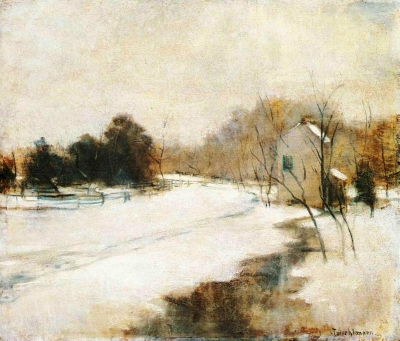
Twachtman moved back to the United States in 1885 and, after living in various places, moved his family to Greenwich, Connetticut, in 1889 or 1890. Family life at his 7-hectare estate in Greenwich provided the leading subject matter for his art through the next decade. He returned to specific sites on the property and painted them repeatedly during different weather conditions and changing seasons, seeking to convey his personal reponse to the sensuous aspects of nature.
By the mid-1890s, Twachtman's career became fully identified with the Impressionist movement, and US critics often compared him to Monet. Twachtman's brush- work, however, usually differed from the broken strokes of other US Impressionists. He varied his paint application from rich, tactile strokes to dry, chalky surfaces. His palette brightened during the 1890s when he often depicted close-up views of flowers, corners of the garden, and other favorite spots on the farm, as in The White Bridge and Waterfall, Blue Brook.
By 1897, Twachtman became a founding member of "The Ten American Painters" (or "The Ten"), a group of artists who seceded from the Society of American Artists and exhibited together for the next 20 years. Of "The Ten," Weir, Childe Hassam, Willard Metcalf, and Twachtman were united by their rejection of descriptive art in favor of more subjective, innovative interpretations of nature. Twachtman created some of his most bold and experimental works for inclusion in this group's landmark exhibitions.
Beginning in 1900, Twachtman spent his summers in the artist colony of Glouchester, Massachusetts. A boldness and spontaneity is evident in his late Gloucester subjects, which are among the strongest and most aggressive works of his career. In these paintings he returned to the broadly brushed style of his Munich period and reintroduced black into his palette to capture the grittier images of life in Gloucester's commercial fishing docks. As in Wild Cherry Tree or Harbor View Hotel, his use of daring compositions with simplified, geometric abstractions suggests his innate understanding of 20th century modernism.
Twachtman, estranged from his family, was living in Gloucester when he died suddenly, a bitter and lonely man.
inchide 
Newsletter
Stay tuned with arts. Subscribe to Artline art news send directly to your mailbox by artLine.ro



